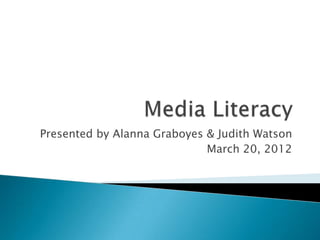
Plc workshop media literacy presentation
- 1. Presented by Alanna Graboyes & Judith Watson March 20, 2012
- 2. In 1962 – Marshall McLuhan “Marshall McLuhan - The World is a Global Village (CBC TV)” YouTube.com. 29 March 2009. healthcarefuture. 31 January 2012 <http://www.youtube.com/watch?v=HeDnPP6ntic&feature=yo utu.be>.
- 3. • Herbert Marshall McLuhan, 1911 -1980 • Canadian educator, philosopher, and scholar, Professor of English literature, literary critic, and a communication theorist. • McLuhan's work is viewed as one of the cornerstones of the study of media theory. • He wrote about the Global Village (1962)which “predicts” the evolution of the World Wide Web* thirty years before it was invented. *first coined in 1990
- 4. ability to “Media Literacy is the access, analyze, evaluate and create media in a variety of forms.” CONTENT FIRST – PRODUCTION LATER Experiential: turning research into a product utilizing the various media formats (e.g. Prezi, Photostory, Moviemaker, ……..)
- 6. According to the ASCD publication, T+D Magazine (Training and Development) ….. “One of the critical skills for workforce 2020 is new media literacy: leveraging, critically assessing, and developing content using new media forms”. “Critical skills for workforce 2020: the institute for the future teamed up with the University of Phoenix Research Institute to identity the following skills, in light of several current economic drivers, that will be needed to thrive in the workplace." T+D Sept. 2011: 19. Academic OneFile. Web. 1 Feb. 2012.
- 8. No. Based on our observation students believe all their answers to their research lie in: 1 site or from 1 magazine article or from 1 book or from one of their favorites 1 encyclopedia (Wikipedia) Most of the time diverse formats are not used OR are the sources critically evaluated. Their products become a babble of information.
- 9. Bias Format of information (unique qualities) Target audience
- 10. More than one source is necessary to form a reaction/evaluation
- 11. Steinberg, Saul. New Yorker . March 29, 1976. Cover. Web. 31 January 2012. <http://www.newyorker.com/magazine/covers/1976>.
- 12. written, visual, auditory, verbal is unique, and needs to be evaluated accordingly. • e.g. the written word conveys information differently than a visual format, e.g. a movie.
- 13. • Is the information trying to sell you something? • Is the information trying to teach something? • Is the information trying to convince you of something? • Is the information assuming its audience is coming to it with prior knowledge. • In the case of an advertisement – was the ad addressing the appropriate audience
- 14. 1. Who is the author? 2. What’s the purpose of the message? Consider the target audience. 3. How was the message constructed?
- 15. • Teach the use of valid search tools • Teach students to search & evaluate multiple information sources • Teach students to think creatively by developing their questioning skills • Foster media literacy as a lifelong skill
- 18. Lettering Layout Target audience Relationship between pictorial elements and written material Signs Symbols Effectiveness (impact on product) Implicit message
- 19. Character development Plot Writing style Voice Theme Motif Symbols
- 20. Visual Details Relationship between pictorial elements and written material Art quality Page structure Techniques Readability & flow (bubbles, symbols, punctuation, eyes, folk characters, ghosts)
- 21. a textural book (which has only text) or a picture book with only pictures ◦ It takes both pictures and text to create the story. The pictures don’t just illustrate the text. Look at content differently: supernatural creatures play a major role. Notice every visual detail. The artist conveys as much information as possible in a limited amount of space. Nothing is accidental. Question what you see (and don’t see) e.g. If a character has long hair – why? If there is a rug in a room? Does it have stripes? that’s significant ( it provides visual texture) Is there a door? perhaps there is a trapdoor Where is the reader? Bird’s eye view, eye level, images off center The structure of the page is critical to the storyline and you need to know how to physically read the page. You need to be able to interpret balloons, bubbles, eyes, posture, punctuation and symbols.